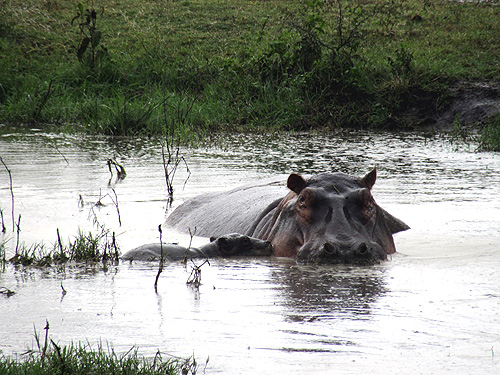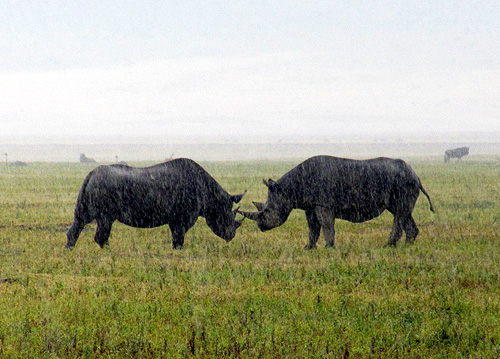 Hyaena, hippo and the remarkable northern wheatear framed below the brilliant stormy skies of the crater were our special attractions, today.
Hyaena, hippo and the remarkable northern wheatear framed below the brilliant stormy skies of the crater were our special attractions, today.
Ngorongoro Crater has got to be one of the handful of most amazing places anyone can visit. Once the highest structure on earth, this super volcano blew its stack geologically quickly, causing untold devastation and leaving for us today one of the most awesome and beautiful structures on our planet.
The crater rim is 1600-1800 feet above a 100 sq. mile caldera that is a wildlife and scenic paradise. Totally wild, this crucible of wilderness changes radically with the least change in weather and so is a precious barometer of what climate change means.
Forced into smaller and smaller ponds because of the exceptional dryness of this year, we found a pod of hippo mothers with young! Now to understand how unusual this is, note that the normal behavior of a female hippo that has just given birth is to sequester herself and her offspring far away from other hippos.
Normally this means several weeks to a month alone and out of sight. The weather in northern Tanzania has been seriously dry, though, and particularly in the crater hippo ponds are substantially shrunk.
So we saw a collection of around 20 adult hippos and at least 5 very small babies (all under a month), crowded together and seeming to do very well. Was this a nursery herd, so to speak?
Hyaena have a heyday when the veld is stressed. Many predators do, but the hyaena especially since it eats almost anything it steps on.
We must have seen at least 100 hyaena. They were eating ankle bones, dead meat, harassing buffalo (!) and even daring to come into our picnic area! Clearly they were juiced up, and every one of them was fat.
The giant lion pride we saw was also fat, so that meant no action. The 20 in the pride on the table mountain on the west side of the crater were totally sacked out. Only the cubs gave us any action.

My personal highlight was seeing the bird in the crater that I regularly see in Alaska in June! The northern wheatear undertakes one of the most unbelievable migrations of any creature on earth: nearly 10,000 miles one-way (of course twice annually).
For the last several years the climate in East Africa (as throughout the whole world, I suppose) has been unusual.
Currently throughout most of northern Tanzania and southern Kenya it’s seriously dry. In the last several days we may actually have seen the dry spell breaking. We witnessed magnificent storms as we left Tarangire and throughout the day in Manyara, and game viewing today in the crater was a dosey doe with very heavy rains.
But if this is the end of the dry spell, the past effects will obviously linger for a while. I reckon less than half the usual numbers of animals were waiting for us today in the crater. Those that were there, several thousand wildebeest and twice or more than of zebra, had very young babies and were probably very late births, constricting them from moving.
None of the animals appeared sick or weak, as would be the case in a real drought. I’m sure we’ll learn more as we head now into the Serengeti for our last five days.
Stay tuned!
